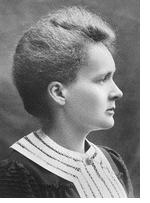Marie Sklodowska Curie
nuclear physicist, b. 7 November 1867 (Warsaw, Poland), d. 4 July 1934 (near Sallanches, France)
 Marie Sklodowska grew up under difficult circumstances. Her father, a teacher of mathematics and physics, had become poor through bad investment decisions, and Marie had to earn her living early. Having won a gold medal for her final results at the Russian lycée at the age of 16, she worked as a teacher and gave clandestine lectures to women at the Polish nationalist "free university".
Marie Sklodowska grew up under difficult circumstances. Her father, a teacher of mathematics and physics, had become poor through bad investment decisions, and Marie had to earn her living early. Having won a gold medal for her final results at the Russian lycée at the age of 16, she worked as a teacher and gave clandestine lectures to women at the Polish nationalist "free university".
At the age of 18 Marie took up a position as governess, which increased her earnings to such a degree that she could finance her sister Boronia's medical studies in Paris. The sisters had an agreement that Boronia would later finance Marie's studies. This became possible in 1891, when the 24 year old Marie came to Paris to study physics. Her prodigious memory helped her to progress quickly. Living on bred, butter and tea, she studied day and night and in 1893 was best of the final class in physical sciences and second in the licence of mathematics in 1894.
On 25 July 1895 Marie Sklodowska married Pierre Curie. The marriage established a unique scientific partnership crowned by several discoveries that resulted in two Nobel prizes. In 1903 Marie and Pierre Curie with Henri Becquerel were awarded the Nobel Prize for Physics; in 1911 Marie alone was awarded the Nobel Prize for Chemistry.
Already before her marriage Marie had taken a position in a research laboratory. In the summer of 1898 she and Pierre discovered a new element, which she called polonium in memory of her native land. A few months later the pair discovered radium.
Marie was looking for a subject for her thesis and was drawn to the discovery, made in 1896 by Henri Becquerel, of a phenomenon which she later called "radioactivity". She decided to find out if the property discovered in uranium could be found in other elements and discovered (in the same year as G. C. Schmidt) that this was true for thorium. She received her doctorate in science in 1903 for her work to isolate radium in its poor metallic state, work that led to her first Nobel Prize.
In 1900, three years after the birth of her first child, Marie Curie was appointed lecturer in physics at the École Normale Supérieure for girls in Sèvres. Shortly after the birth of her second child in 1904 she became chief assistant in the laboratory directed by her husband Pierre. In 1906 she was appointed as Pierre's successor on the chair at the Sorbonne (the University of Paris) that had been left vacant through her husband's sudden death in a traffic accident during the same year. She was the first woman to teach at the Sorbonne.
Her fundamental treatise on radioactivity, published in 1910 was instrumental to bring Marie Curie the Nobel Prize for Chemistry in the following year for the isolation of pure radium. The University decided to build a dedicated Radium Institute. Construction began in 1914, and the institute became fully operational after the end of World War I in 1918. During this period Marie Curie and her daughter Irène concentrated on applications of X-radiography. The Institute became an international centre of nuclear physics and chemistry and its medical applications. Marie Curie's name was now known throughout the world, and in 1922 she became a member of the Academy of Medicine.
Her studies of radioactivity had convinced Marie Curie that systematic research in nuclear physics was impossible without a secure supply of intense radioactive sources, and the Institute placed great emphasis on producing a stockpile of radium. The 1.5 grams that had accumulated over a period of several years provided the basis for the experiments performed in the 1930s by her daughter Irène and her husband Frédéric Joliot-Curie and their discovery of artificial radioactivity in 1934. Marie Curie could witness the discovery but died few months later from leukemia, the result of exposure to radiation from her many experiments. France honoured her immense contribution to physics by enshrining her ashes in the Panthéon in 1955, making her the first woman to receive such an honour.
home
 Marie Sklodowska grew up under difficult circumstances. Her father, a teacher of mathematics and physics, had become poor through bad investment decisions, and Marie had to earn her living early. Having won a gold medal for her final results at the Russian lycée at the age of 16, she worked as a teacher and gave clandestine lectures to women at the Polish nationalist "free university".
Marie Sklodowska grew up under difficult circumstances. Her father, a teacher of mathematics and physics, had become poor through bad investment decisions, and Marie had to earn her living early. Having won a gold medal for her final results at the Russian lycée at the age of 16, she worked as a teacher and gave clandestine lectures to women at the Polish nationalist "free university".